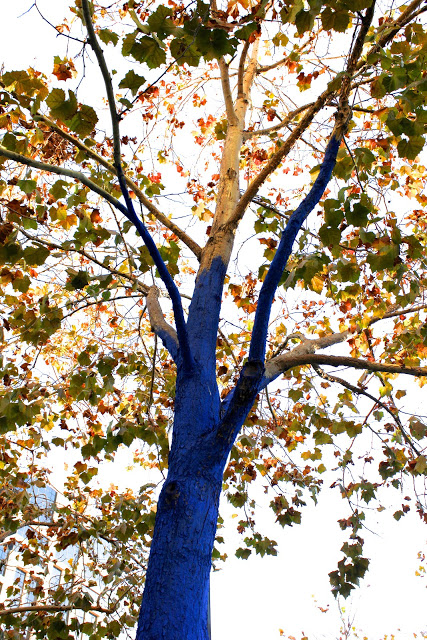A Blue Tree Grows in Sacramento
Fortunately, I managed to avoid an existential crisis through a run-in with the Sacramento Tree Foundation, who told me what's up. The trees are not blue. Well, they ARE blue, but not naturally anyway. (Well of course, I know my tree morphology and know that North American trees are not typically blue).
These trees are a part of an art installation that Sactree.com states is an "effort to call attention to global deforestation, and is supported by several local organizations and businesses because of its ability to call attention to Sacramento's valuable urban forest." There is no paint involved, and no toxic substances are applied to the trees or anything that would clog lenticels or cause harm to the tree. The blue color is a non-toxic dye pigment that will last for no more than six months, before it weathers away.
Konstantin Dimopoulos is the brilliant mind behind this project, which he has also taken to Melbourne, Vancouver, Auckland, Seattle, and Gainesville, FL. Below is a description of the project and the meaning behind it:
"The Blue Trees is a social art action. Through colour I am making a personal statement about the spirituality of trees and their importance to our very survival: trees are the lungs of the planet.
Colour is a powerful stimulant, a means of altering perception and defining space and time. The fact that blue is a colour that is not naturally identified with trees suggests to the viewer that something unusual, something out of the ordinary has happened. It becomes a magical transformation.
In nature colour is used both as a defensive mechanism, a means of protection, and as a mechanism to attract. The Blue Trees attempts to waken a similar response from viewers. It is within this context that the blue denotes sacredness, something reverential.
Trees are largely invisible in our daily lives, and it’s not until it’s too late that we realise how important they are to us both aesthetically and environmentally. Each year an area at least the size of Belgium of native forests is cleared from around the planet.
Yet while we do this we look at whether other planets can be inhabited, so we’ve got somewhere else to go once we’ve destroyed our own.
The colour used on the trees is biologically safe pigmented water. As an ephemeral artwork, the colour will naturally degrade and the trees gradually revert to their natural state."
I love it when nature and art collide. If given the opportunity, be sure to check these out!
